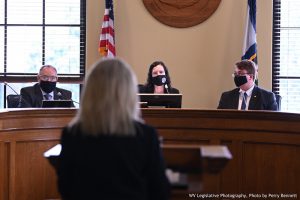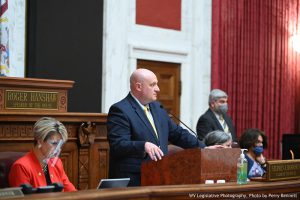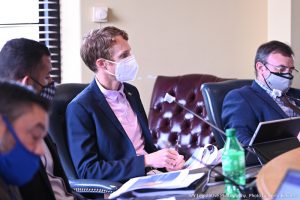Legislative Oversight Commission on Education Accountability – May 10, 2021.
The Legislative Oversight Commission on Education Accountability met during May interims. The Commission received a report from the Property Tax Division. The report was on the progress of county assessors to access the required 60% of market value level properties.
Hancock County and Marshall County are the only counties that fall below in any individual category. However, all counties are overall compliant.
The Commission also received updates on the following policies from the State Board of Education: Policy 2422.7 – Standards for Basic and Specialized Health Care Procedures, Policy 4150 – Student Driver Eligibility Certificate, Policy 5309 – County Superintendent Performance Evaluations, Policy 2512 – Transformative System of Support for Early Literacy, and Policy 2800 – Regulations for Juvenile Diversion and Transition Programs. Several of the policies are pending board approval this week.
Policy 2422.7 provides the standards for WV certified school nurses to assess student health needs and decide who is best skilled to respond to them. The proposed revisions to the policy would guide to school nurses who provide the care and/or delegate school-aged-student care.
Policy 4150 provides uniform guidelines for driver eligibility for students ages 15 to 17. The changes in this policy are to reflect changes made in Policy 2510, Assuring the Quality of Education: Regulations for Education Programs.
Policy 5309 regulates the approval processes by which county BOEs evaluated their superintendent’s performance. The amendments provide clarity.
Policy 2512 creates the Transformative System of Support for Early Literacy. The proposed amendments update language to reflect current practice and collaborative partners.
Policy 2800 establishes the rules and regulations for schools operated by the WV Schools of Diversion and Transition in providing education programs and services for students in juvenile corrections centers, juvenile detention centers, residential treatment facilities, and truancy diversion classrooms. The proposed amendments remove outdated language in the WCSDT policy and prodders manual.
For the full report, click here.
Legislative Oversight Commission on Health and Human Resources Accountability – May 10, 2021.
The Legislative Oversight Commission on Health and Human Resources Accountability met during May interims to discuss two topics. First, a discussion of Senate Bill 509, which proposed removing a requirement that determination of mental stability is found before admission to a mental health facility.
Senate Bill 509 failed to become law during this past session. The bill passed the Senate but was left on the inactive calendar in the House and was never voted on by that body.
What it proposed was a change in the current code to determine whether an individual is medically stable before admission to a mental health facility in every case. Previously, it was required that a licensed physician make that determination.
The final position of the bill would have proposed a strike and insert amendment to allow a circuit court, magistrate, or mental hygiene commissioner, in the involuntary commitment process, to order an exam of a person by a health care practitioner to determine medical stability in addition to a mental health examination for the purpose of a probable cause hearing.
 Additionally, the strike and insert changed the institution of final commitment proceedings from 10 days to 15 days. Likewise, the time limit for the conclusion of proceedings is changed from 20 to 30 days. And finally, the strike and insert would have allowed a sheriff, arresting officer, or certified municipal police officer, once notified by the state hospital that the hospital lacked bed capacity, to take an individual to a diversion facility designated by the chief medical officer of the state hospital.
Additionally, the strike and insert changed the institution of final commitment proceedings from 10 days to 15 days. Likewise, the time limit for the conclusion of proceedings is changed from 20 to 30 days. And finally, the strike and insert would have allowed a sheriff, arresting officer, or certified municipal police officer, once notified by the state hospital that the hospital lacked bed capacity, to take an individual to a diversion facility designated by the chief medical officer of the state hospital.
Speakers to the committee included the Chair of the Department of Psychiatry & Behavioral Medicine at Marshall University, the CEO of the Appalachian County Mental Health Center, the Cabell County Mental Hygiene Commissioner, and a representative from the West Virginia Sheriffs’ Association. They all expressed concern with the original proposal and a willingness to work together in a subcommittee to come up with a better way moving forward. They all agreed there that a one size fits all proposal would not work.
Next, the committee heard a report on behavioral health facilities in West Virginia from the Office of Health Facility Licensure and Certification (OHFLAC) within the Department of Health and Human Resources. The report detailed complaints over the past two to three years.
There are three kinds of behavioral health providers in West Virginia: group homes, which include intermediate care facilities for individuals with intellectual disabilities (ICF/IID), and residential units; outpatient services, including day programs; and substance use disorder facilities providing behavioral health services. These centers provide services for the treatment of individuals at-risk of or suffering from mental, behavioral, or addictive disorders.
According to the report, there are 611 licensed behavioral health sites in West Virginia, not including IDD waiver homes with three or fewer individuals. Of those, 228 are residential group homes.
The Director of OFLAC told the committee that the top complaints from all behavioral health centers in 2020 were abuse and neglect by staff, violation of rights and safety concerns. Intermediate care facilities and homes with more than three people are more carefully inspected than the waiver homes. The licensed homes require health inspections and fire marshal inspections and must be Americans with Disabilities Act compliant. The federal Centers for Medicaid and Medicare inspect the residences and provide oversight. But waiver homes are only inspected when there is a complaint. The list of incidents does not differentiate between the facilities, indicating that the issues are pervasive throughout the system. In several instances, neglect by staff led to deaths.
For the full report, click here. For a listing of incidents, click here.
The director further stated that there is a workforce issue, both in finding qualified professionals to assist these individuals and within her office. There are nine surveyors for behavioral health within OHFLAC and three vacancies. However, beginning June 1, OHFLAC will be able to assess civil money penalties against facilities that fail to come into compliance. State code will also be updated relating to patient rights, care and safety. And DHHR continues to work to get facilities into compliance.
Joint Legislative Committee on Flooding – May 10, 2021.
The Joint Legislative Committee on Flooding heard updates from the State Resiliency Office, RISE WV and Hazard Migration HUD Grant, Flood Insurance, and current flood situations from the WV Emergency Management Division.
RISE WV and Hazard Migration HUD Grant, Flood Insurance, and current flood situations from the WV Emergency Management Division.
The State Resiliency Office noted SB 389 would take effect July 4, 2021. The Office is Updating the State Flood Protection Plan, which is projected to be complete in Mid- 2022.
The Office currently has five working groups: WV Silver Jackets, State, FEMA and HUD Collaboration, Debris Management, Hazard Migration Joint Planning Committee, and the State Flood Protection Plan Update.
The WV Silver Jackets work to establish intergovernmental partnerships to create a comprehensive and sustainable solution to state flooding hazards. The collaboration between State FEMA and HUD increases communication between all sectors of federal, state, and local governments, therefore, increasing WV’s resiliency to disaster. The Debris Management Plan provides for organized clean-up after an emergency or natural disaster. The Hazard Mitigation Joint Planning Committee reviews and updates the current State Mitigation Plan as needed. The plan is to act as a framework model for counties and municipalities to reduce loss and prevent injury from all hazards. The State Flood Protection Plan is designed to reduce flooding damage in the future.
For the full report, click here.
RISE WV notified the Committee that the agency’s Housing Restoration Program doubled its accomplishments from last year. The agency has completed construction on 296 houses with 102 remaining. Of the 102 houses remaining, 79 are in the construction phase. These are homes that were affected by the 2016 flood.
Multifamily Housing Program provides housing to vulnerable households by offering to repair damaged multifamily rental houses. Projects for Community and Economic Development are projects that serve low-income areas. The Bridge Home Program reconstructs privately owned brides that provide primary access to a residence; 36 bridges have been completed. The Clearance and Demolition Program removes abandoned and deteriorating buildings; 42 demolitions have been completed.
For the full report, click here.
The WV Emergency Management Division seeks to increase Finance, Public Assistance, and Migration staff. The agency has experienced a decrease in staff. The agency has bimonthly virtual assessments of the current flood situation. The 2016 flood remains the largest public assistance and migration gran ever in WV.
This year there have been two major disaster declarations; both were in February. One was an ice storm in Cabell, Lincoln, Mason, Putnam, and Wayne counties. The other was a flood in Boone, Cabell, Kanawha, Lincoln, Logan, Mingo, and Wayne counties.
The Division working to update policies, procedures, and training. The Emergency Operations Center utilized virtual platforms due to COVID. The agency is implementing new software. The agency utilized DOC inmates and DOH for debris removal. Assistance was provided from the WV State Police, WV Forestry Division, DNR, and the National Guard to perform welfare checks in heavily damaged and inaccessible areas after disasters.
For the full report, click here.
Joint Legislative Committee on Government and Finance – May 10, 2021.
 The Joint Committee on Government and Finance received an update on Broadband in the state. The committee received the monthly reports from the Lottery Commission, the Revenue Department, WorkForce WV, DHHR on CHIP and Medicaid, the WV Investment Management Board, and Workers Comp. Most of the updates were positive.
The Joint Committee on Government and Finance received an update on Broadband in the state. The committee received the monthly reports from the Lottery Commission, the Revenue Department, WorkForce WV, DHHR on CHIP and Medicaid, the WV Investment Management Board, and Workers Comp. Most of the updates were positive.
Proposed are four ARPA Broadband programs: Existing Network Line Extensions, Rapid Wireless Deployment Projects, Major Broadband Infrastructure Investment, and Local Government/Matching Broadband Funding Incentive. The four-part plan will cost $138 million of the federal American Rescue Plan Act funds. The primary objective is to get broadband to those who do not have it, then focus on improving broadband in the areas that do have it.
The Lottery Commission has introduced a new scratch-off that minimizes the cost of production, which in turn maximizes returns. The Lottery Revenue for March was $118.3 million.
April was a recovery month for the General Revenue Fund, which is at $539.8 million, up 38.9 percent increase from where it was last year. Sales tax is doing well because people are spending the stimulus payments. Personal Income Tax collections are up $98 million from what was estimated.
The WorkForce WV’s update included unemployment numbers. The March rate was 6.1 percent, a 0.8 percent decrease from the previous month. Some counties do have higher rates.
The CHIP program has had payment issues and complaints. The agency is working to get to the root of the problems and solve them. DHHR expects there not to be a Medicaid waitlist by the end of the year.
The WV Investment Management Board reported great numbers, up 21.4% from last Fiscal year. March’s numbers were up 2.8% from February.
For the full report, click here.

